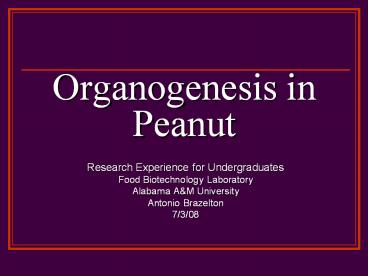Organogenesis in Peanut - PowerPoint PPT Presentation
1 / 26
Title:
Organogenesis in Peanut
Description:
Organogenesis in Peanut Research Experience for Undergraduates Food Biotechnology Laboratory Alabama A&M University Antonio Brazelton 7/3/08 ... – PowerPoint PPT presentation
Number of Views:744
Avg rating:3.0/5.0
Title: Organogenesis in Peanut
1
Organogenesis in Peanut
- Research Experience for Undergraduates
- Food Biotechnology Laboratory
- Alabama AM University
- Antonio Brazelton
- 7/3/08
2
Introduction
- What is tissue culture?
- Why is it important?
- How can tissue culture be applied to peanut
improvement?
3
What is tissue culture?
- Tissue culture - is the culture and maintenance
of plant cells and organs. - Important parameters in tissue culture
- - Type of explants leaf, stem, hypocotyl, root,
petiole, etc. - - Medium
- Macro nutrient and Micronutrients
- Vitamins
- pH
- - Hormones
- Cytokinins - TDZ, BAP
- Auxins - NAA
- - Photoperiod
- - Aseptic technique
4
Why is tissue culture important?
- Plant tissue culture has value in studies such
as cell biology, genetics, biochemistry, and
many other research areas. - Crop Improvement
- Genetic Transformation
- Plants can be produced quickly
- Plantlets can be used for germplasm conservation
5
Pathways
- Organogenesis
- Relies on the production of organs either
directly from an explant or callus structure - Somatic Embryogenesis
- Embryo-like structures which can develop into
whole plants in a way that is similar to zygotic
embryos are formed from somatic cells - Existing Meristems
- Uses meristematic cells to regenerate whole
plant.
(SourceVictor. et al., 2004)
6
Steps in Organogenesis
- Phytohormone Perception
- Dedifferentiation of differentiated cells to
acquire competence. - Reentry of cells into the cell cycle
- Organization of cell division to form specific
organs primordia in meristem
(SourceVictor. et al, 2004)
7
Peanut and Tissue Culture
- Importance of Peanut
- Current status of peanut organogenesis
8
Plan of Action
- To use two species of peanut for comparison.
- To germinate, regenerate and finally use
organogenesis to produce whole plant from the
hypocotyledon. - Use different parameters to find optimum
conditions of regeneration and organogenesis.
9
Objective
- To compare peanut regeneration through
organogenesis using different hormones and
hormones at different concentrations.
10
Methods
(. Source Li. et al, 2003)
Fig 1. Flow Diagram for peanut regeneration
11
Hormone ConcentrationsPrepare 3 medium
solutions
- TDZ (Thidiazuron) 10uM, 15uM,
20uM - BAP (Benzylamineopunine) 10uM, 15uM, 20uM
- HA (Humic Acid) 12.5 mg/L, 25
mg/L, 50mg/L
12
Sterilization
- make sure seeds contain no fungi or bacteria
- Protocol for Sterilization
- Soak seeds in 20 Clorox (2x) 30min
- Rinse with sterile water (2-3x)
- Soak seeds in sterile water (1 hour)
- Soak again and Leave Overnight
- Rinse with sterile water (2-3x)
(SourceVictor.et al, 2004)
13
Germination
- Protocol for Germination
- Sterilize hands with 70 Iso-proponol.
- Remove seed , split each down the center to
reveal the embryo. - Use knife to cut embryo away from endosperm.
- Collect embryos and proceed to culture .
- Use 10 embryos per plate
14
- Embryo in culture
- Germinating embryo
- Elongating shoot
- well elongated shoot
- Single well elongated shoot
- Hypocotyl explant
- Contaminated plate
Fig. 5 Steps in peanut regeneration
15
!!Contamination!!
16
Germination using 3 different hormones at 3
different concentrations
2
3
1
BAP
2
3
1
TDZ
2
1
3
HA
17
(No Transcript)
18
Conclusions made from Regeneration
- All 3 hormones bring about germination.
- On an average HA gave the best results for
germination. - Change in concentration of the hormones did not
necessarily change the germination success. - For both root and shoot germination HA gave the
best results of the 3 hormones used.
19
Regenerated Explant
REGENERATION
20
Organogenesis Protocol
- Cut hypocotyl and reculture in same hormone
concentration.
21
Organogenesis
22
Organogenesis
1
2
3
BAP
2
1
3
TDZ
1
2
3
HA
23
Organogenesis
24
Conclusions of Organogenesis
- Peanut regeneration through organogenesis has
been done. - Growth regulators such as TDZ, BAP, and HA
stimulate plant regeneration. - Both TDZ and BAP produce more viable shoots
during organogenesis. - Lower concentrations gave better results.
- Ongoing work includes replicating the procedure
using other species of peanut plant.
25
Future Research
- To find the effect of other factors such as,
- - pH
- - temperature
- - nutrients
- - vitamins and
- - enzymatic poisons
- on peanut germination and regeneration.
26
Acknowledgements
- AM University,
- Dr. Konan and his students.
- North Alabama Center for Educational Excellence
- Dr. Wang
- NRES STAFF
- REU Colleagues

